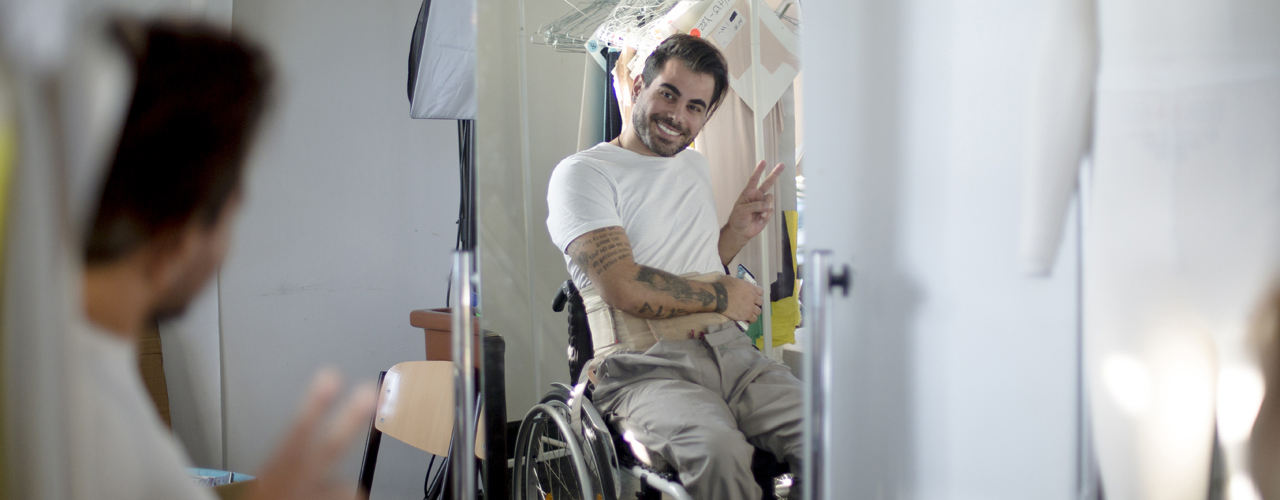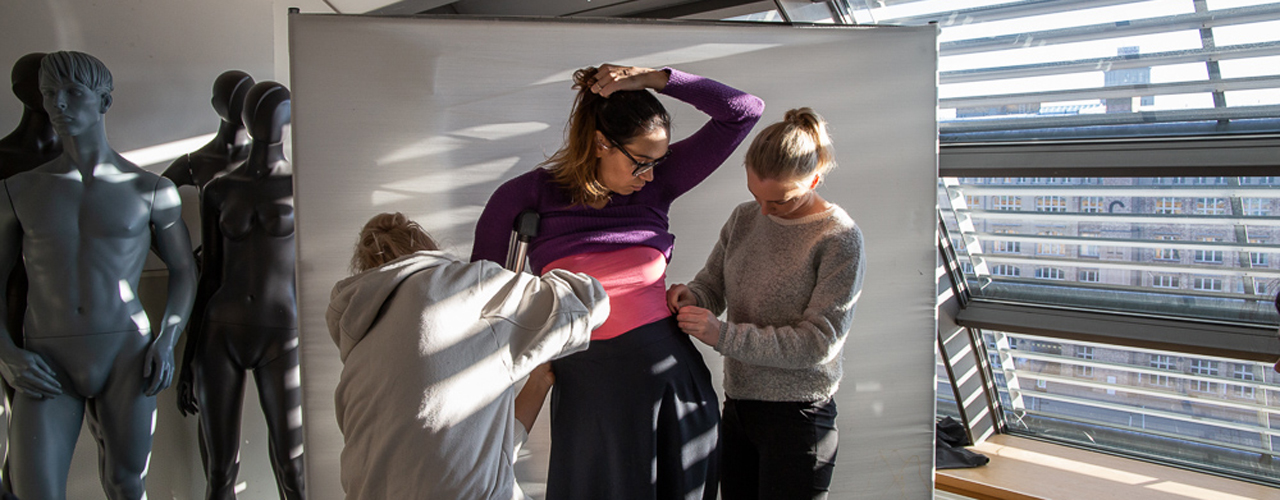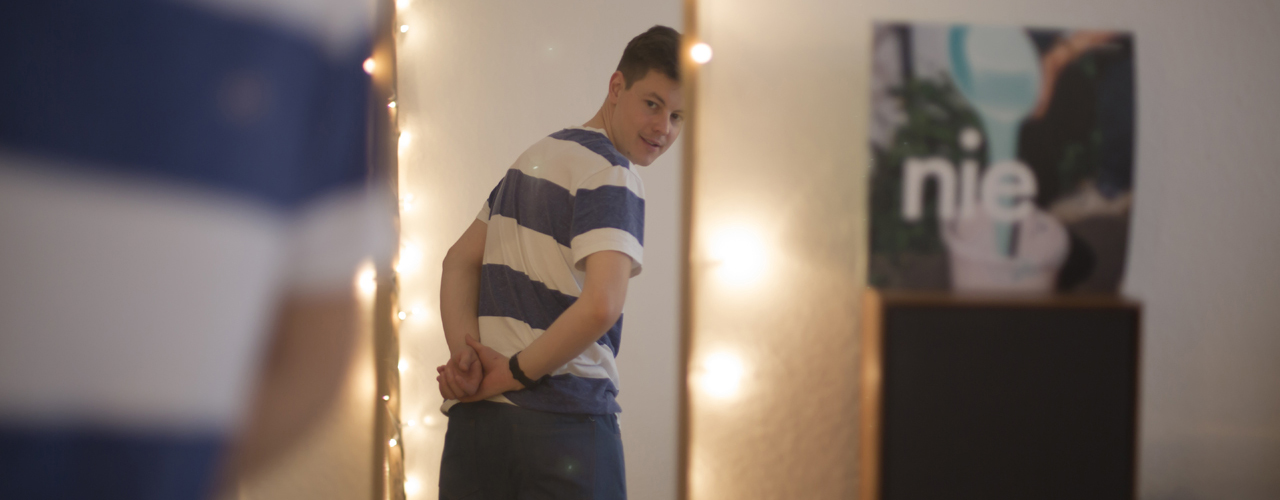Fashion for Everyone
Because fashionable clothing for people with disabilities is still rare, students of the degree programme Clothing Technology/Fabric Processing at HTW Berlin took the initiative themselves: In the project "Smart Clothing for People with Disabilities", they developed clothes and aids that not only fit, but are also fashionable for models with physical disabilities. We talked to three of them about how important fashion is to them and what problems they have in everyday life when buying clothes. The lecturer Dr. Yanina Urusova supervised the project.
Aidin Chaichi: "My big dream is to work in fashion"

"Fashionable clothing is very important for me, also for my Instagram photos on my account @aidin2afm, where I currently have 242 thousand followers. The pictures there show me before and after my accident four years ago. I'm from Iran and used to be a model. I worked with big labels and appeared in music videos. Four years ago, I was involved in a car accident and have been in a wheelchair ever since. I've been in Germany for about a year now.
For me, clothes should be chic and fashionable and I like to wear designer clothes. However, I also like to combine them with pieces from more affordable suppliers. Sometimes it is hard for me to find clothes, for example a suit for special occasions or a more extravagant party outfit. If you're sitting in a wheelchair, you need longer trouser legs because they slip up quickly. In addition, a dressing aid would be good. The students of HTW Berlin immediately understood my problems; working with them was very pleasant. My big dream for the future would be to work in fashion. For example, I would like to become a fashion designer and complete a training or a degree in this field. I have already created a folder with design samples. My clothes are meant to be for everyone, for people with and without disabilities."
Ksenia Liutova: "Fashion should be accessible to all people"

"I am very happy to be part of the 'Smart Clothing for People with Disabilities' project. I hope it will be an impulse and that the topic will develop further. Fashion should be accessible to all people. Fashionable clothing is an important part of my life. I go shopping mostly in big department stores, but it is often difficult to find suitable clothing. I would describe my style as classically beautiful, but it can also be a bit sexy. Garments should bring out the good sides, but I also want the sides that I don't want to put in the foreground to be concealed. At the age of five, I got under a train; my right arm and my right leg were amputated. At the moment, I am not wearing a prosthesis and use a crutch. Because of the crutch, the material under my arm tears quickly, because often the material is not so strong. The crutch also rubs against the trousers, which also causes them to wear out more. The empty trouser leg is rather an aesthetic problem and I prefer to have it shortened. However, this is also difficult because it is becoming increasingly rare for shops to offer tailoring services. The cooperation with the students of HTW Berlin was very nice. I went shopping with a project participant and she took notes about my wishes. In their designs, for example, the students dealt with the fact that I need stronger fabrics that are more durable. They also designed trousers for me that I can wear without a prosthesis."
Willi Struwe: "My work trousers now look much better on me"

"It's hard for me to find trousers that fit well. The prosthesis means that one of my legs is thinner than the other. This can look a bit strange, especially if I wear narrow-cut trousers. The students in the project “Smart clothing for the disabled” developed a special cover for my prosthetic socket. It’s basically an accessory that makes the prosthesis wider to balance out the difference in size, without making the prosthesis heavier. The students also designed a pair of trousers with a zip at the bottom. I can open up the bottom of the trouser leg to make it wider, just like you do with buttons on shirtsleeves. As the prosthetic foot always remains at the same angle, it’s often difficult to pull up a pair of trousers over it. This mechanism makes it much easier. Working together with the students was really great. We sat down together and identified the problems which they could help me with. We then had regular fitting sessions. The students talked with my orthopaedic technician to find out what they needed to take into account when designing something for a prosthesis. Various details and the fabric ensure that the cover does not slip. It would be fantastic if such a cover were also available for other prosthesis wearers. It really makes a big difference having something like this. I've had my disability since 2013. I used to work as a railway shunter, which basically involves operating the locomotives by remote control while you stand there and attach or detach carriages, for example. One winter, I slipped off the board and fell under the train. I still work as a train driver for @deutschebahn, but I no longer do any shunting. Instead, I drive trains on regional routes around Berlin. This has always been my dream job since a very young age, and I enjoy it a lot. My work trousers now look much better on me thanks to the cover!"